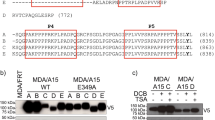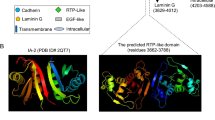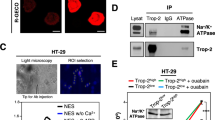Abstract
The human homologue of the Drosophila discs large tumor suppressor gene (hDlg) is a member of the membrane-associated guanylate kinase family with three PSD-95/Dlg/ZO-1 (PDZ) domains. hDlg has been shown to bind tumor suppressor proteins, adenomatous polyposis coli (APC) and protein tyrosine phosphatase and tensin homologue (PTEN), and several viral oncoproteins, and has been implicated in the negative regulation of cell proliferation. hDlg has furthermore been shown to localize at the plasma membrane of synapses and to scaffold cell surface receptors and channels. In epithelial cells, hDlg localizes at the basolateral plasma membrane, but its localization mechanism is unknown. We searched here for a transmembrane protein that directly bound to hDlg. hDlg bound tumor endothelial marker 5 (TEM5), a seven-pass transmembrane protein that is homologous to the family B of G-protein-coupled receptors (GPCRs). TEM5 has previously been reported to display elevated expression during tumor angiogenesis and neoangiogenesis. The PDZ domains of hDlg bound the C-terminal PDZ-binding motif of TEM5. The expression of TEM5 was detected in endothelial cells of embryonic liver, where hDlg colocalized with TEM5. hDlg furthermore bound a novel seven-pass transmembrane protein, which was homologous to TEM5, and was named here a TEM5-like protein (TEM5-like). These results suggest that hDlg localizes at the plasma membrane through TEM5 and TEM5-like and furthermore scaffolds these GPCRs in endothelial cells during tumor angiogenesis and neoangiogenesis.
This is a preview of subscription content, access via your institution
Access options
Subscribe to this journal
Receive 50 print issues and online access
$259.00 per year
only $5.18 per issue
Buy this article
- Purchase on Springer Link
- Instant access to full article PDF
Prices may be subject to local taxes which are calculated during checkout







Similar content being viewed by others
Abbreviations
- aa:
-
amino acid(s)
- Ab:
-
antibody
- EGFP:
-
enhanced green fluorescent protein
- GK:
-
guanylate kinase-like
- GPCR:
-
G-protein-coupled receptor
- GPS:
-
GPCR proteolysis site
- GST:
-
glutathione S-transferase
- hDlg:
-
human homologue of the Drosophila discs large tumor suppressor
- LRR:
-
leucine-rich repeat
- MAGUK:
-
membrane-associated guanylate kinase homologue
- MBP:
-
maltose-binding protein
- PDZ:
-
PSD-95/Dlg/ZO-1
- RTQ-RT-PCR:
-
real-time quantitative reverse transcriptase/polymerase chain reaction
- SDS–PAGE:
-
sodium dodecyl sulfate–polyacrylamide gel electrophoresis
- SH3:
-
Src homology-3
- TEM5:
-
tumor endothelial marker 5
References
Baldwin HS, Shen HM, Yan HC, DeLisser HM, Chung A, Mickanin C, Trask T, Kirschbaum NE, Newman PJ, Albelda SM and Buck CA . (1994). Development, 120, 2539–2553.
Bockaert J and Pin JP . (1999). EMBO J., 18, 1723–1729.
Bradford MM . (1976). Anal. Biochem., 72, 248–254.
Budnik V . (1996). Curr. Opin. Neurobiol., 6, 858–867.
Cai C, Coleman SK, Niemi K and Keinanen K . (2002). J. Biol. Chem., 277, 31484–31490.
Carson-Walter EB, Watkins DN, Nanda A, Vogelstein B, Kinzler KW and St. Croix B . (2001). Cancer Res., 61, 6649–6655.
Chothia C and Jones EY . (1997). Annu. Rev. Biochem., 66, 823–862.
Dimitratos SD, Woods DF, Stathakis DG and Bryant PJ . (1999). Bioessays, 21, 912–921.
Fredriksson R, Gloriam DEI, Höglund PJ, Lagerström MC and Schiöth HB . (2003). Biochem. Biophys. Res. Comm., 301, 725–734.
Fujiwara T, Tanaka K, Mino A, Kikyo M, Takahashi K, Shimizu K and Takai Y . (1998). Mol. Biol. Cell, 9, 1221–1233.
Hanada T, Lin L, Chandy KG, Oh SS and Chishti AH . (1997). J. Biol. Chem., 272, 26899–26904.
Humbert P, Russell S and Richardson H . (2003). BioEssays, 25, 542–553.
Ide N, Hata Y, Nishioka H, Hirao K, Yao I, Deguchi M, Mizoguchi A, Nishimori H, Tokino T, Nakamura Y and Takai Y . (1999). Oncogene, 18, 7810–7815.
Ishidate T, Matsumine A, Toyoshima K and Akiyama T . (2000). Oncogene, 19, 365–372.
Ji TH, Grossmann M and Ji I . (1998). J. Biol. Chem., 273, 17299–17302.
Kim E, Niethammer M, Rothschild A, Jan YN and Sheng M . (1995). Nature, 378, 85–88.
Kim E and Sheng M . (1996). Neuropharmacology, 35, 993–1000.
Laemmli UK . (1970). Nature, 227, 680–685.
Leonard AS, Davare MA, Horne MC, Garner CC and Hell JW . (1998). J. Biol. Chem., 273, 19518–19524.
Lue RA, Marfatia SM, Branton D and Chishti AH . (1994). Proc. Natl. Acad. Sci., USA, 91, 9818–9822.
Matsumine A, Ogai A, Senda T, Okumura N, Satoh K, Baeg GH, Kawahara T, Kobayashi S, Okada M, Toyoshima K and Akiyama T . (1996). Science, 272, 1020–1023.
Murata M, Buckett PD, Zhou J, Brunner M, Folco E and Koren G . (2001). Am. J. Physiol. Heart Circ. Physiol., 281, H2575–H2584.
Pawson T and Scott JD . (1997). Science, 278, 2075–2080.
Reuver SM and Garner CC . (1998). J. Cell. Sci., 111, 1071–1080.
Stacey M, Lin HH, Gordon S and McKnight AJ . (2000). Trends Biochem. Sci., 25, 284–289.
Takai Y, Irie K, Shimizu K, Sakisaka T and Ikeda W . (2003). Cancer Sci., 94, 655–667.
Takeuchi M, Hata Y, Hirao K, Toyoda A, Irie M and Takai Y . (1997). J. Biol. Chem., 272, 11943–11951.
Tejedor FJ, Bokhari A, Rogero O, Gorczyca M, Zhang J, Kim E, Sheng M and Budnik V . (1997). J. Neurosci., 17, 152–159.
Thomas U, Phannavong B, Muller B, Garner CC and Gundelfinger ED . (1997). Mech. Dev., 62, 161–174.
Woods DF and Bryant PJ . (1991). Cell, 66, 451–464.
Woods DF, Hough C, Peel D, Callaini G and Bryant PJ . (1996). J. Cell Biol., 134, 1469–1482.
Acknowledgements
We thank Dr T Akiyama (The University of Tokyo, Tokyo, Japan) for providing us with the cDNA of hDlg, and Dr S Nishikawa (Kyoto University, Kyoto, Japan), Dr M Shibuya (The University of Tokyo, Tokyo, Japan), and Dr Y Sato (Tohoku University, Miyagi, Japan) for helpful discussion. The investigation was supported by grants-in-aid for Scientific Research and for Cancer Research from the Ministry of Education, Culture, Sports, Science and Technology, Japan (2002, 2003); and by the Kanae Foundation for Life & Socio-Medical Science (to KI).
Author information
Authors and Affiliations
Corresponding author
Rights and permissions
About this article
Cite this article
Yamamoto, Y., Irie, K., Asada, M. et al. Direct binding of the human homologue of the Drosophila disc large tumor suppressor gene to seven-pass transmembrane proteins, tumor endothelial marker 5 (TEM5), and a novel TEM5-like protein. Oncogene 23, 3889–3897 (2004). https://doi.org/10.1038/sj.onc.1207495
Received:
Revised:
Accepted:
Published:
Issue Date:
DOI: https://doi.org/10.1038/sj.onc.1207495
Keywords
This article is cited by
-
High incidence of imperforate vagina in ADGRA3-deficient mice
BMC Biology (2024)
-
ADGRA1 negatively regulates energy expenditure and thermogenesis through both sympathetic nervous system and hypothalamus–pituitary–thyroid axis in male mice
Cell Death & Disease (2021)
-
Improved affinity at the cost of decreased specificity: a recurring theme in PDZ-peptide interactions
Scientific Reports (2016)
-
The Adhesion GPCR GPR125 is specifically expressed in the choroid plexus and is upregulated following brain injury
BMC Neuroscience (2008)
-
Control of tumourigenesis by the Scribble/Dlg/Lgl polarity module
Oncogene (2008)



